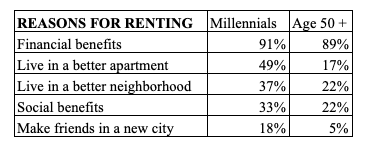Is 50 the New 20 When It Comes To Roommates?

Insight on the unexpected fastest-growing segment of roommate-seekers: Baby Boomers
- The number of people over 50 living with roommates is growing at nearly 2x the rate of any other age group.₂
- 9 in 10 renters 50+ say they live with roommates for the financial benefits.₁
- Of people over 50 living with roommates, 1 in 5 are living with roommates for the first time.₁
- 63% of renters over 50 are rent burdened.₁
- Renting with a roommate vs living alone can save renters over $25,000 a year.₃
What we found about our fastest-growing user segment - people ages 50 and older₂
Our data reveals that the number of people over the age of 50 living with roommates has grown by 27% in the past year.₂ According to Harvard University’s Joint Center for Housing Studies, 2.6 million older people are living as roommates with non-relatives.
To find out what’s driving baby boomers to look for roommates and how their habits, preferences, and motives for renting differ from the millennial generation, we surveyed over 6,000 roommates in the United States.
Are baby boomers more financially burdened or financially conscious than their successors?
Data suggests the older generations are increasingly having to share their homes as the cost of living and inflation rates continue to rise - 9 in 10 users over 50 said they share a home primarily for the financial benefits.₁
Additionally, big life changes, such as divorce, are playing a part. 1 in 5 renters over 50 said they were living with a roommate for the first time in their lives.₁
Millennials also said financial benefits were the main reason they share living space, however, they also took other factors into consideration. 49% said the option to live in a nicer apartment was a factor for choosing to live with roommates and a third cited the social benefits.₁

While millennials may recognize more benefits for renting with roommates than the older group, only 41% describe renting with roommates as a choice, saying they couldn’t afford to live alone, while 55% of baby boomers said they are financially stable enough to live alone but prefer to have roommates.₁
Income vs. Cost of Living
Millennials reported a higher annual income than renters aged 50+. However, 23% of respondents over 50 are retired. The biggest annual salary bracket reported by millenials (36%) was $50,000-$75,000. Meanwhile 29% of Baby Boomers reported an income between $30,000-$40,000.₁
70% of respondents over the age of 50 described their current rent as affordable, however 63% said more than a third of their current salary goes on rent. According to HUD those who spend more than 30% of their income on housing are considered rent burdened.
Living with roommates vs. living alone
According to SpareRoom data, renting with a roommate can save people over $25,000 a year.₃
While majority of 50+ think of renting with a roommate as a choice, the demographic recognizes the financial benefits of sharing later in life.
Tom MacThomas, SpareRoom’s US General Manager, comments:
“People think of apartment sharing as a young person’s game, but that’s no longer the case. The over 50s might not be the biggest group of roommates but they’re definitely the fastest growing.
There are two main reasons for this but both have their roots in affordability. Rents have risen far more over the past decade than salaries. That means some people are lifelong renters, while another group are coming back to sharing, or even sharing for the first time, in their 50s. It’s a trend we see continuing well into the next decade, if not further ahead.”
Notes to Reader:
₁SpareRoom’s survey of 6,000+ roommates, February 2019
₂Number of live ads on SpareRoom in the U.S., 2017, 2018.
₃Mean cost per room on SpareRoom listings vs. median cost per 1 BR on Zumper.com, February 2019
